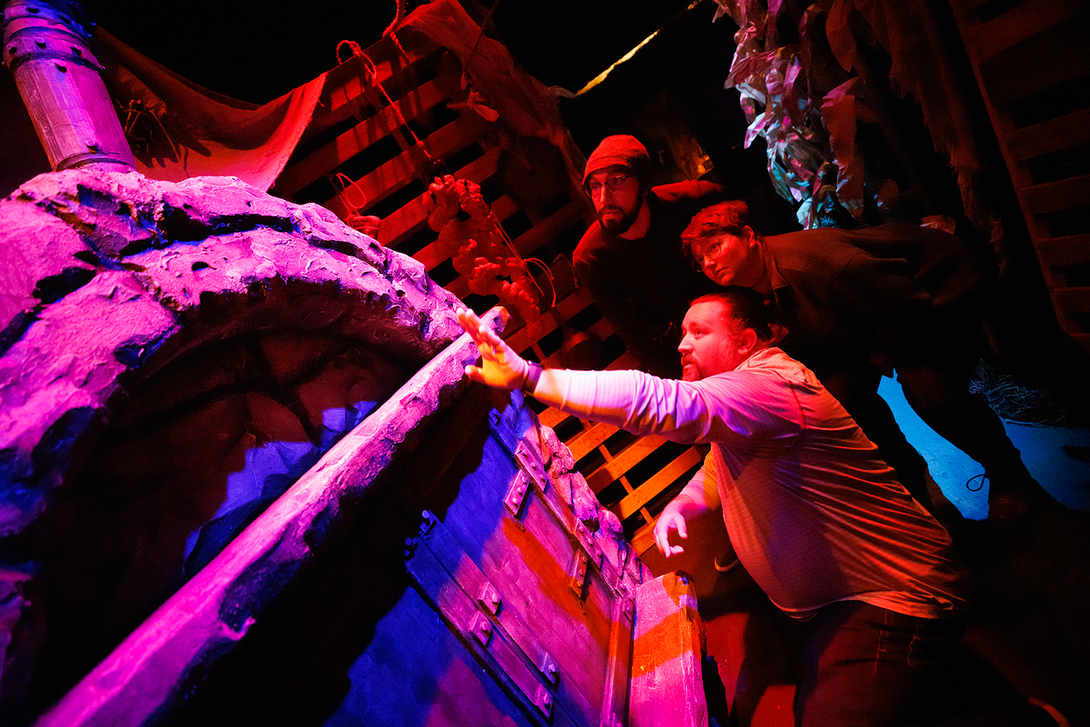
JD Madsen has a unique recruiting tool for the Johnny Carson School of Theatre and Film’s scenic design program.
“It’s me,” said Madsen, director and associate professor of scenic design. “Boy, that’s egotistical sounding, but it’s my willingness to be there with them, for them and to help them. Yeah, we have cool toys, we have money and support and can do great things, but really the best recruiting tool I have is that I will know them, because I have to know them to help them.”
This exemplifies Madsen’s passion for mentoring University of Nebraska–Lincoln students, which he brings to the set of shows like ShakesFear. Madsen, an esteemed designer, guides students through their journey from apprentice to master with a student-defined success model. When he’s not mentoring students and teaching, he can be found working in the industry, spending time with his wife and kids, golfing or pursuing one of his other design hobbies such as game design.
“ShakesFear is a fun, odd beast,” Madsen said. “It allows students to explore design ideas beyond the traditional approaches. We don’t do a lot of like audience autonomy where they can walk through a space or touch things so those are not the things our students generally think about, even though they will be issues that they’ll encounter in various entertainment industries when they leave. Having a project like this allows us to show them how that works and provides a lot of value to them.”
Taylor Walters-Riggsbee, a third-year scenic design graduate teaching assistant, found immense value on the set of ShakesFear as an assistant designer.
“I worked on designing the Catacombs,” she said. “This was my first time working to make a haunted house and I had the opportunity to try out new materials and techniques. I was also able to work closely with my peers and professor as a fellow designer and there were so many learning opportunities to be had. There were many days where I felt like I was fulfilling my dream of being a ‘real designer.’”
Madsen, ShakesFear’s co-lead designer along with Jill Hibbard, his former student, tailored students’ ShakesFear roles to their experiences and interests.
ShakesFear, which is in its second year, is a theatrical haunted house centered around finding one of Shakespeare’s lost plays. Madsen and Hibbard divided the ShakesFear set into pieces that fit the students. Each student was responsible for a piece of the puzzle, while Madsen and Hibbard were responsible for cohesiveness and the overall experience. For example, an undergraduate student was assigned to the Midsummer Night’s Dream zone whereas a graduate student was assigned a new portion of the experience that would require more development.
“Then those individual students would design or pitch ideas or try something new and then come to me and say, ‘is this the right track’ And I would say yes or give notes,” Madsen said. “So my job is to kind of make sure that there is an artistic quality and consistency across the thing that feels like it is a human United experience, even if it was divided into these little pieces.”
Tailoring the student experience is one of the ways that Madsen sets his students up for success through mentorship. On the set of Shakesfear, Madsen oversaw three graduate and nine undergraduate set design students. In the program, there are 14 graduate students and 30 undergraduates. Madsen gets to know each of his students and dedicates time to cultivating their talents and mentoring them, something he views as essential to his job as an educator.
“I have a theory in my mentoring and advising that’s called a student-driven success model,” he said. “The students have to tell me what success means to them, and then I’ll help them get there, rather than a mentor-driven success model because I don’t want to tell them what success in their lives and careers should look like, but I want to help them feel successful.”
Madsen’s mentorship is felt and positively recognized by his students. Walters-Riggsbee felt that Madsen was one of the few people who were not afraid of her educational interests. She felt that the extra educational experiences that Madsen and other professors provided led her to opportunities such as working with Meow Wolf and Busch Gardens Tampa Bay.
“JD adapts his mentorship to the needs of his students,” Walters-Riggsbee said. “He listens to their goals and aspirations to develop a plan for their education. He is here to make us the best humans, not just the best artists, that we can be and holds us to the goals that we set out. He wants us to feel as though we can take on any challenge that may come our way in the future.”
When Madsen arrived at the university nine years ago, he brought over 20 years of set and environmental design experience, with much of his time spent on well-known stages. He earned his master’s degree in scenic design from the University of Maryland, where he then taught 3D drafting and pre-visualizations before coming to Nebraska.
Through his time at Nebraska, Madsen has continued to enjoy teaching, mentorship and flexing his own creative muscles. In addition to his time spent with his family and friends, Madsen stays busy as an expert in his field with continued work on shows all over the country and internationally, including a holiday experience in Hong Kong and engaging in training with Punchdrunk in London. When he’s not working with set design, he’s pursuing his passion for all kinds of design, especially analog game design.
The work of Madsen, Hibbard, design students and more can be seen at Nebraska Repertory Theatre’s ShakesFear through Oct. 30.







